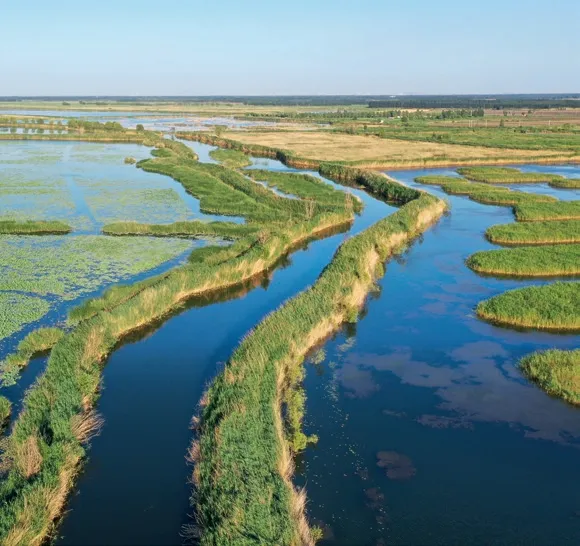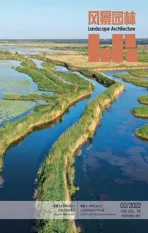区域水系统营建
2022-03-22王晞月

风景园林学科的工作对象面向广大的土地地表空间,工作内容主要涉及人工营建的建成环境和自然区域2个范畴。一方面,人们在建成环境中关注自然的营造,以满足人类对于自然空间的原始追求;另一方面,在国土及区域的视角下,以人工干预的方式介入自然系统,通过整理土地、梳理自然过程、营建区域风景,形成适于人居的环境领域。
区域水系统是以自然水文过程为基底,辅以人工梳理的方式,对地表水资源进行综合利用、服务于所在区域人居环境的重要支撑系统,它为一城一地提供了基本的环境支撑和安全保障。这种具有自然和人工双重属性的系统结构是人居环境营建过程中形成的基于自然本底的解决方案,用低介入、高效率及综合功能的方式应对并不理想的自然水文环境。从古至今,随着人类足迹覆盖的区域不断扩大,人们对自然空间中水系的梳理从未停歇,针对复杂而多样的地理环境和气候条件,因地制宜地改造自然、兴修水利,梳理区域水系统网络,为农业生产、生活用水、运河传输等提供安全、可控的水资源与水环境。在干旱的区域使用沿坡引潜流和地下传输的方式避免蒸发;在河谷盆地区域利用地势营建塘渠进行传输与分流;在山前平原或浅山地带,依托山体建造蓄泄可控的陂湖以最大限度地蓄积山体汇水;在山地区域开辟梯田,顺山势进行逐级灌溉,实现水资源的高效利用;在低地沼泽区域构建圩田系统,通过调整水陆关系,营建适宜耕作的土地区域和相应的人居空间;在滨海冲积平原区域建造海塘、堰坝和灌渠,拒咸蓄淡……同时,这些土地整理的成果也为城市空间的营建提供了基本结构,支撑区域水文安全的水系统也成为城市的环境支撑系统,影响着城市中山水形势、布局结构与风景体系等。如此,人们通过主观能动地改造并利用自然山水,来实现营建城市这样具有高效、集约化特征的人居环境的目的。
历史上中国人尤其擅于依据自然条件改造水与土地的环境来获得更加安全和丰产的土地,在国土上诸多特定的地理单元构筑了人工与自然紧密结合、相互适应的典型区域水系统,如先民建造于天目山前河网平原的良渚塘坝水利系统、成都平原上的都江堰水利工程、太湖平原的圩田水网工程,以及杭嘉湖平原地区诸多的陂湖水利工程均是此类系统的典范。同样在世界范围内,这样的因地制宜的水利梳理方式为许多国家和区域带来安全、稳定与繁荣,如古巴比伦王国修建于幼发拉底河上的纳尔汉谟拉比渠;建设于公元前3世纪的马拉水库;古罗马帝国建设的一系列城市供水系统以及引水渠道;为贯通航道开展贸易而开凿的苏伊士运河与巴拿马运河以及荷兰为适宜低地滨海耕作而营建的圩田水网系统。
区域水系统在为人类提供安全与稳定的水环境基础上,亦承担着养育民生生计、提供风景游憩功能和催化人文艺术发展的作用。一方面,这些散落在土地上的水网塘渠、湖泊港汊是人居空间中独特的风景线,经诗词歌赋、艺术作品的渲染与世代传颂,为众多城市构建了融山合水、诗情画意的风景体系。水不仅成为人们眼中生动而美好的图景画卷,亦是人们心中对于一方土地乡土地脉的空间想象。同时,人们围绕着水展开生产生活,或捕鱼放棹,或泛舟为市,或采菱种藕,水成为一个区域生活方式与文脉的底色乃至经济繁荣的动脉,世世代代影响着扎根这片土地的人们。
由此可见,从古至今区域水系统都是区域水文安全、生产生活、自然生态以及风景建构的重要支撑系统,承载了区域自然和文化的复合特征,发挥着城乡基础设施的重要作用。然而随着现代化城市建设,一些传统的基础设施系统因不断被蚕食而失效,造成了污染、内涝、生境破坏等一系列环境问题,又不得不依靠昂贵和生硬的现代基础设施来解决,带来更高强度的干预与破坏。这需要我们不断反思,现下对于水系统的建设及对于水资源的开发利用是否超出了自然承载能力,历史上传统水系的内涵是否得到了充分认知与价值沿袭,是否有更优的统筹与协调水生态空间与建设空间的方式……
在现今国土空间规划等综合性、系统性战略发展路径逐步实施的大背景下,区域水系统的视野提醒我们,城市不应是脱离自然环境而孤立存在的单体,对于任何一个城市空间的规划与设计都应充分认知其所在的山水格局与多元的自然禀赋,在尊重、利用自然脉络的基础上,在保持人居空间与自然环境动态平衡的系统稳定中寻求发展的路径。可以说,区域水系统提供了将城市及其所在地理单元进行统筹考虑的重要视角,是构建区域人居生态环境的重要基础与媒介,并且有机遇成为当今城市应对生态环境问题挑战、探索生态文明建设路径乃至实现大区域协同发展的重要解决方案与实施抓手,从而以区域水系统为载体营造具有水文安全、生态韧性、诗意风景、独特人文价值且可持续发展的人居生态环境共同体。

Regional Water System Construction
The discipline of landscape architecture, which takes the vast land surface space as its work object, mainly involves two categories: the built environment of artificial construction and natural area. On the one hand,focusing on the creation of nature in the built environment, people create the environment to meet their original pursuit for natural space. On the other, from the perspective of region, artificial intervention is carried out based on the context of natural system to form an environment suitable for people’s survival and life through land consolidation, natural process sorting and regional landscape construction.
Regional water system is an important environmental support system for regions, which makes comprehensive use of surface water resources based on natural hydrological processes and supplemented by artificial combing, providing basic environmental support and security for cities and their regions. It can be said that such a system with both natural and artificial attributes is a nature-based solution formed in the process of human settlement construction, which deals with the natural hydrological environment that is not ideal in a low-intervention, highefficiency and multi-functional manner. Since ancient times, people have been combing the water system. Human beings are constantly exploring to undertake water conservancy projects according to specific geographical environment and climate conditions, thereby providing safe and controllable water resources and water environment for agricultural production, domestic water use and canal transportation. In arid areas,people use underground transport and well drilling to avoid evaporation;in valley basin areas, the terrain is used for transmission by pond channels; in the piedmont plains or shallow mountain zones, impounding lake system is built so that runoff water can be collected to the maximum extent; in mountainous areas, terraced fields allow irrigation being carried out step by step along the mountain to realize efficient water utilization;in lowland area, polder system is constructed to create suitable land areas for farming and corresponding living spaces; and in the coastal alluvial plains, seawalls, weirs and channels are built to intercept salt water and store fresh water... Simultaneously, settlements and cities are built accordingly, the land consolidation experience has gradually evolved into the basic structure of city space, and the water system that supports regional hydrological security also works for the cities. By transforming and using the natural landscape subjectively and actively people could build an efficient and intensive living environment.
Historically, to obtain more productive and secure land, the Chinese have adapted their environment to natural conditions. As a result, a variety of typical regional water systems were constructed in specific geographical units, in which the artificial and the nature are closely combined and adapted to each other, such as Liangzhu water conservancy system, Dujiangyan water conservancy project in Chengdu Plain, polder water network in the Taihu Plain, impounding lakes in Hangjiahu Plain and etc.. There were many such approaches adopted in other regions in the world, which have brought security, stability and prosperity to many countries, including Narl-Hammurabi channel built by the Kingdom of Babylon on Euphrates, the Mala reservoir built in the 3rd century BC,a series of city water systems and aqueducts built during the Roman Empire, the Suez and Panama Canals built to link shipping lanes for trade, and polder system for lowland coastal farming in the Netherlands.
Regional water system not only furnishes human beings with a safe and stable water environment, but also plays the role of raising people’s livelihood, providing recreation landscape and promoting the development of humanities and arts. On one hand, these water networks, ponds, rivers and lakes scattered on the land constitute a unique landscape in the living space, building poetic landscape system for many cities, which, in people’s minds, has become not only a vivid picture, but also a spatial imagination of a place after passed on generations by poems, songs and works of art.Besides, water has become the background color of a region’s lifestyle,like fishing, or boating, or harvesting, or trading, and even the artery of economic prosperity, affecting the people rooted in the land for generations.
Thus, from ancient times to the present, regional water system has been an important support system for region’s security, production and living, natural ecology and landscape construction, bearing the composite characteristics of regional nature and culture, and playing a crucial part in urban and rural infrastructure. Today, however, with the construction of modern cities, some traditional infrastructure systems have been encroached, losing their original functions, as a result of which, a series of environmental problems such as water pollution, water-logging and habitat destruction emerge, which need to be solved relying on modern infrastructure, thus bringing further intensity intervention and destruction.This requires constant reflections: Does the construction of water system and the exploitation and utilization of water resources exceed the natural carrying capacity? Has the connotation of traditional water systems in history been fully recognized and their value been inherited ? Is there a better way to coordinate water ecological space and construction space?
In the context of the gradual implementation of reform paths in territorial space planning, the perspective of regional water system can remind us that cities should not be isolated from the natural environment,that for the spatial planning and design of any city, we should fully understand their landscape pattern and diverse natural endowments and that we should seek the path of development while maintaining the system stability of dynamic balance between human settlement space and natural environment on the basis of respecting and utilizing the natural context. Regional water system, which provides an important perspective to consider the unity of cities and their geographic units, is the foundation and medium of constructing regional human settlement ecological environment and has the potential to become a way for cities to deal with the challenges of ecological environment and explore the construction of ecological civilization and even an important solution to realize the coordinated development of large regions. Therefore, regional water system should be used as the carrier to build a sustainable community of human settlements ecological environment with hydrological security,ecological resilience, poetic scenery and unique humanistic value.
Acquiring editor of the current issue: WANG Xiyue
January 26, 2022
